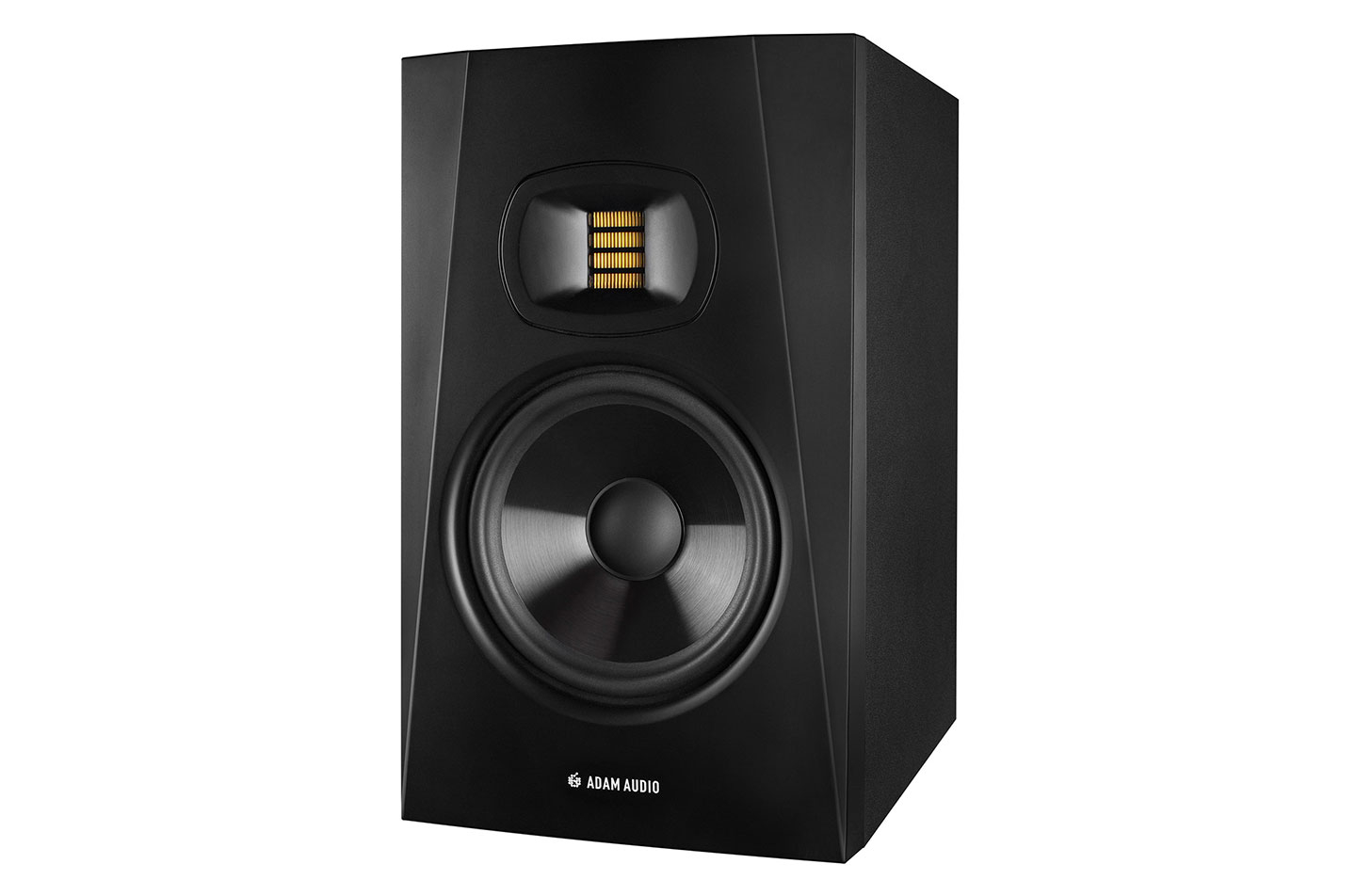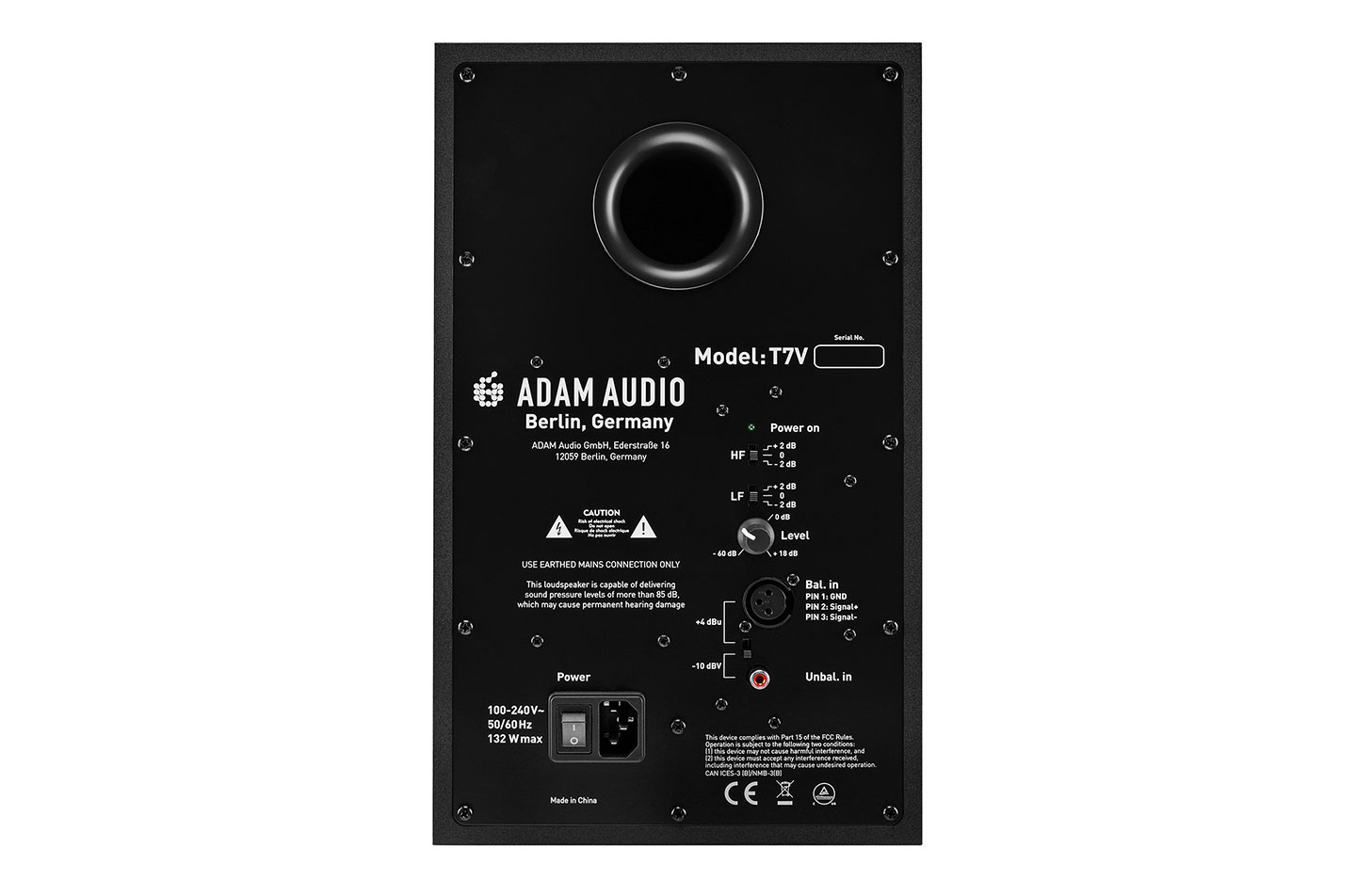- High-end monitoring for producers on a budget.
- Like Funktion-One's angular horns, ADAM Audio's yellow tweeters inspire confidence. Staring out of their monitors like all-seeing golden eyes, the so-called Accelerated Ribbon Tweeters are the Berlin company's calling card. They're a key part of the ADAM sound, offering a vivid sound stage, balanced mid-range and a present top-end. ADAM have managed to become synonymous with high-end monitoring, so the announcement of the reasonably priced T Series range certainly piqued the interest of producers on a budget.
Like their F Series predecessors, the new line is remarkably close in performance to the pricier AX Series. The T Series is something of a departure, however, boasting internal analogue-to-digital conversion, DSP and Class-D amps. My tests mostly involved pitching the T5V, a five-inch design, against the A8X, an eight-inch model that's more than three times as expensive as the T5V. The T Series model is noticeably lighter, weighing in a good five kilos lighter than the A8X. Whereas the latter appears modular in appearance, the former looks more like a single-piece construction. One niggle with the new model is the lack of a power switch or volume control on the front side of the monitor. Still, trading hundreds of dollars for reaching around the back to switch it on isn't such a bad trade off. There you'll find unbalanced RCA and balanced XLR inputs, with a little switch for toggling between the two. Mild frequency shaping comes in the form of low- and high-shelf switches providing +/-2db of gain. It's not a huge range to work with although in practice I kept them flat. But if you were working in a confined room where the speakers had to be kept close the walls, being able to cut some low frequencies would certainly be a welcome option. Finally, there's a gain control with a range of -60dB to +18dB.
The real differences are in the bass porting. The T5V has a single hole cut out of the back whereas the A8Xs have two carved out of the front. Ideally the T5V would have ports on the front, although this probably has something to do with manufacturing costs. This means you need to be careful not to place them too close to the walls of your workspace, as you can end up with resonant clouds of fake bass hooting into your ears. Port placement notwithstanding, the bass response is decidedly meaty for this price point. There is a minor hump around 100hz and an equally shallow scoop out of the low-mids, which gives the lower content in kicks and basslines a refined, uncluttered feel. The region around the fundamental is boosted, as you'd expect from a ported design, but the low-mid scoop counteracts overcrowding in the upper harmonics. Lower mid-range frequencies are a constant danger area in the mix, but the T5V's pleasant curve doesn't mean you're flying blind. You can tell the A8Xs have greater detail and extension in this zone, which is to be expected given the price tag, although the T5Vs and a pair of nice headphones were enough for me to separate the low-end body of percussion from hooty harmonics in kicks and basses. Even without a sub, there's just enough low air to feel in your chest at higher volumes, something that can't be said for many monitors in this price range.
The star of the show, however, is the upper mid-range. This is where those golden tweeters come into play. According to ADAM, the T5V's U-ART tweeter has the same "HPS Waveguide" as their top-of-the-line S Series. In layman terms, this helps tame early reflections bouncing off your desk, producing a wider listening sweet spot and tighter stereo imaging. If you're a producer who's forced to over-use headphones due to dodgy acoustic environments, the T5V's depth, both left-to-right and front-to-back, is a great antidote to the trapped-in-your-head spread of a headphone mix. Another important point is the flat response in the vital 1-5kHZ range. Picking out resonances and masking in this region is remarkably transparent for such a cheap monitor, comparable even to the A8Xs. Separation between elements in the mix was also noteworthy.
There's a bit of air added to the top-end but not at the expense of overall balance. Monitoring at low volumes is a breeze as the extra extension gives your ears a little more information to latch on to, coming off more as air than sizzle. Monitors in this price range can tend to create an artificial sense of clarity or impact with a crispy curve above 5kHz, which sometimes comes off as harsh or throaty. For lack of a better term, the T5Vs sound warm and pleasant in comparison. On the other hand, they're certainly not dull, conveying a mix's energy and transient definition with admirable ease. As such, they're a nice option for home DJ usage, especially in small rooms.
Of course, the best course of action is to compare the T5Vs with other monitors for yourself. For a lot of people, this just isn't possible. In such cases, the T5Vs are a safe choice. This price bracket can be a bit of a minefield, as are the rooms these monitors often end up in. At the very least, you can consider the T5Vs a known quantity. They have character and are pleasant to listen to but they're not flattering or confusing in the mix. They're clinical where it counts and the compromises are workable. They've only been out for a few months, but I've yet to come across any truly negative takes. And given their similarity to the A8Xs, you'd be hard-pressed to find a better all round option in this bracket.
Ratings:
Cost: 4.7
Versatility: 4.0
Ease of use: 4.0
Sound: 4.3
 There's a bit of air added to the top-end but not at the expense of overall balance. Monitoring at low volumes is a breeze as the extra extension gives your ears a little more information to latch on to, coming off more as air than sizzle. Monitors in this price range can tend to create an artificial sense of clarity or impact with a crispy curve above 5kHz, which sometimes comes off as harsh or throaty. For lack of a better term, the T5Vs sound warm and pleasant in comparison. On the other hand, they're certainly not dull, conveying a mix's energy and transient definition with admirable ease. As such, they're a nice option for home DJ usage, especially in small rooms. Of course, the best course of action is to compare the T5Vs with other monitors for yourself. For a lot of people, this just isn't possible. In such cases, the T5Vs are a safe choice. This price bracket can be a bit of a minefield, as are the rooms these monitors often end up in. At the very least, you can consider the T5Vs a known quantity. They have character and are pleasant to listen to but they're not flattering or confusing in the mix. They're clinical where it counts and the compromises are workable. They've only been out for a few months, but I've yet to come across any truly negative takes. And given their similarity to the A8Xs, you'd be hard-pressed to find a better all round option in this bracket. Ratings: Cost: 4.7 Versatility: 4.0 Ease of use: 4.0 Sound: 4.3
There's a bit of air added to the top-end but not at the expense of overall balance. Monitoring at low volumes is a breeze as the extra extension gives your ears a little more information to latch on to, coming off more as air than sizzle. Monitors in this price range can tend to create an artificial sense of clarity or impact with a crispy curve above 5kHz, which sometimes comes off as harsh or throaty. For lack of a better term, the T5Vs sound warm and pleasant in comparison. On the other hand, they're certainly not dull, conveying a mix's energy and transient definition with admirable ease. As such, they're a nice option for home DJ usage, especially in small rooms. Of course, the best course of action is to compare the T5Vs with other monitors for yourself. For a lot of people, this just isn't possible. In such cases, the T5Vs are a safe choice. This price bracket can be a bit of a minefield, as are the rooms these monitors often end up in. At the very least, you can consider the T5Vs a known quantity. They have character and are pleasant to listen to but they're not flattering or confusing in the mix. They're clinical where it counts and the compromises are workable. They've only been out for a few months, but I've yet to come across any truly negative takes. And given their similarity to the A8Xs, you'd be hard-pressed to find a better all round option in this bracket. Ratings: Cost: 4.7 Versatility: 4.0 Ease of use: 4.0 Sound: 4.3